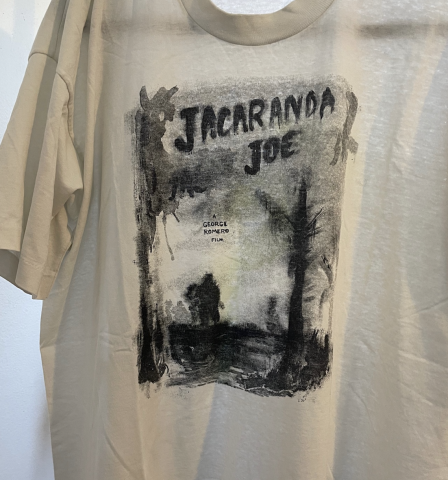Jacaranda Joe: more updates

I've been speaking to crew members who worked on George A. Romero's Jacaranda Joe and will have a more substantial update soon, but, briefly, the film was the second installment of an innovative program devised by Valencia Community College faculty member Ralph Clemente that brough established filmmakers to campus to direct a short film. The previous year, Robert Wise (director of The Haunting, West Side Story, and The Sound of Music), filmed a short called Best Two of Three with Valencia students. Jacaranda Joe was written by Romero with the scope (and limitations) of filming in ten days in central Florida with a student crew in mind. Romero picked up an idea he had first developed two decades earlier, about a tv show that stumbles across a bigfoot society in the woods. Romero transposed this from the woods to the Florida swamps, reduced the bigfoot community to a single "skunk ape" creature, and built the majority of the narrative around a sleazy talk show host's discussion of the brief glimpse of the creature that had come to be known as "Jacaranda Joe." That meant that most of the shoot would take place on a single set. Joe himself only appeared in a single, blurry shot, which meant that while a full creature needed to be designed and executed, it could be relatively simple compared to a monster that needed to be on camera for long stretches of a movie.
There was discussion of Romero returning to continue the rest of the story the following year, but there's no indication that he ever wrote anything else or did any concrete work to develop the project beyond his time at Valencia. Beyond Romero's own interest or other projects (most pressingly Before I Wake) that began to take up his focus, there were basic logistical difficulties to continuing the short film. For one thing, other than Clemente and Joe director of photography Dominic Palmieri, none of the crew would be returning. He'd need to start over, work with a different Assistant Director and Art Director and different Editors and Sound Recordists. Valencia was a two-year school, but the filmmaking program did not begin until a student's second year. So every one of the 40-ish students who were in the filmmaking program graduated shortly after Romero finished shooting in June 1994. The editors who continued working on the film - George Rizkallah (referred to as "Little George" on set bc of his relative height compared to the 6'4" Romero) and Bobby Gibis, both of whom have had long and productive careers in film and TV - did so out of dedication to the project, but the vast majority of the crew were no longer even in the area.
Jacaranda Joe was shot in the awkward transition between film-only shooting and fully digital filmmaking. All in-studio filming was done on 35mm, while exteriors were meant to mimic local news and TV and so were done entirely on video. The 35mm was transferred to video to be edited on a state-of-the-art AVID system, which meant a substantial loss of image resolution. So, the goal was to eventually cut the film on film - a step that was never reached in the post-production process. At this point, digital editing was essentially a way of creating a rough cut to guide the physical cutting of the film prints. There were at least two cuts of the film completed by Rizkallah and Gibis, but titles and credits were never added. So the cuts of the film that were exported to VHS or the digital video formats of 1994 are the only copies of the edited film that had ever existed.
All of this means that there never would have been a public screening of Jacaranda Joe, as the cuts were completed well after graduation, so most of the people who'd have wanted to see the film would no longer have been at the school, and the only copies of the film to be created were on video transfers that were too low-resolution to be projected.
More interviews and research and potential discoveries will be coming soon, but I'm writing now in part bc both Rizkallah and First Assistant Director Michael Sellers have dug out some amazing materials from the shoot, including the crew t-shirt. The archive does not, alas, have a Jacaranda Joe t-shirt of its own, but I think we can all admire just how AMAZING it looks. HUGE thanks to Rizkallah and Sellers for their assistance and for sharing their recollections with me.
- Adam Charles Hart
